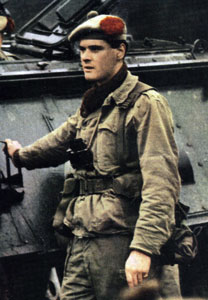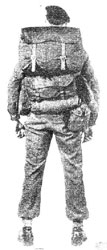 When Patt. ’58 W.E. was first announced in LoCs, in 1959, it was the outcome of quite a protracted period of experimentation and trial. The story actually begins with Patt. ’44 W.E. which had been intended as the new, post-war General Service pattern of accoutrements. Other than for the Parachute Regiment (for its lightness) and the Brigade of Gurkhas, this never happened, Patt. ’44 becoming a Far East “theatre issue”. Exhaustive trials had not been conducted during the War, these taking place in 1946-48 with the 6th Airborne in Palestine and elsewhere. Not only was Patt. ’44 found wanting in various respects, there still remained a requirement to improve on Patt. ’37 W.E.
When Patt. ’58 W.E. was first announced in LoCs, in 1959, it was the outcome of quite a protracted period of experimentation and trial. The story actually begins with Patt. ’44 W.E. which had been intended as the new, post-war General Service pattern of accoutrements. Other than for the Parachute Regiment (for its lightness) and the Brigade of Gurkhas, this never happened, Patt. ’44 becoming a Far East “theatre issue”. Exhaustive trials had not been conducted during the War, these taking place in 1946-48 with the 6th Airborne in Palestine and elsewhere. Not only was Patt. ’44 found wanting in various respects, there still remained a requirement to improve on Patt. ’37 W.E.
In 1950 two R.A.M.C. Lieutenants, O.C.J. Lippold and P.F.D. Naylor, made their first appearance. Assigned to the Army Ordnance Research Group (A.O.R.G.), they issued a preliminary report on their work in February 1950. Of necessity they must have commenced work in 1949, since by the time of the report they had designed a prototype equipment and put it through trials themselves. They satisfied two principles, applying the load “…directly to bone…” and in a position to ensure that the load c.g. coincided as closely as possibly with the body's c.g. They noted three positions that satisfied these criteria, (a) on the head, (b) on the back with friction and (c) on the hips.
This seems to have been Lippold & Naylor’s passport to an event where, as lowly Lieutenants, they were in the very august company of field officers! The Third Commonwealth Conference on Development, Design and Inspection of Clothing and General Stores was held between 17th April and 6th May 1950. On 19 April, on behalf of the U.K., a Brig. R.H. Bellamy presented Paper 11A, Load Carrying Apparatus, covering developments from Patt. ’08 W.E. onwards. He stated that, in the opinion of the General Staff, a fundamental advance on those equipments was necessary and that development should strive to secure. In October 1950, the War Office issued Qualitative Requirement WO / DOS / 155 after which Project ES. No. 443 Personal Load Carrying Equipment was initiated.


Under this project, a large number of different designs were produced and given either an examination, or a trial, just which is not clear. Some of these were theatre-specific (i.e. Cold Wet Weather), others were role-specific, offering no more than a Battle Order. To overcome this last drawback, several designs used what can best be described as “layered packs”, where one envelope was attached to the existing dorsal load. This was not above / below, as with Patt. ’25, or the U.S. M-1944 and M-1945 Field and Cargo Packs. Instead it was in the nature of “behind / behind” – the load extending further out from the wearer’s back. Later designs added a squat, circular-section kitbag, as a top load on the pack. Short lists were produced, fresh trials conducted, probably modifications resulted, then more trials and the outcome of all this appears to have been inconclusive. What seems to have been at least the inspiration for Patt. ’58 was an earlier design, cryptically termed I Stores Design A, though who I Stores actually were, was not detailed, other than being a department at Didcot.
Sadly, Lippold and Naylor’s work did not come to fruition in Patt. ’58. Their conclusions mirrored Lavisse’s own observations in 1902 – that a soldier’s pack should be tall & narrow, with its centre of gravity close to the wearer’s back. Whilst these principles have been adhered to in the civilian market, from the 1970s, they are largely incompatible with a soldier’s load. At that time, no consideration was given to NBC clothing and there can have been no concept of the “armour plate” that encumbers today’s soldiers, which have spawned a totally different approach, that of add-on items to a much up-graded “flak-jacket” – the modern incarnation of the 1942 Battle Jerkin. Certain elements of a U.S. flavour made their appearance, including nomenclatures. There was an American representative on the committees sitting during the development phase and the U.S. was first past the post with their M-1956 LCE.
It is interesting to note that M.W.C.B.Co. - the English subsidiary – had come up with the Yoke concept over 50 years previously. Patent 22,158 / 1903 coupled a modern Yoke, with 4 point attachment, to an old-fashioned Valise Equipment, Pattern 1882 waistbelt. Separate 4- pocket Cartridge carriers were to be attached to the Belt and a pair of “…haversack pockets…” were attached to the Belt by “hanger” hooks, thereby obviating the separately slung Haversack and dorsal load of a Valise. The water bottle and its suspension look distinctly “American”, albeit the bottle looks like a British Bottle, water, enamelled (Mark IV.). Mills would seem to have plagiarised another’s Patent for the Lintott Patent Frame Equipment, which was used by some Victorian Volunteer units. This design had utilised metal strips laminated into the shoulder straps. They could thus be bent to fit the wearer and effectively “hooked” onto the shoulders.
What is not recorded is that this was the End of an Era for MECo. Although they manufactured Patt. ’58, it was not their design, though some of the later changes could have been suggested by them. They would not design another webbing pattern and in the early 1970s were taken over by RFD-GQ, who specialised in parachutes and aircraft safety equipment, in which field MECo had also played a part from before the Second World War. Although it was to be another 30 years, the days of cotton webbing were numbered, the Atomic Age and the requirements of NBC warfare would see to that. In addition, MECo did not work on “planned obsolescence”: their Patt. ’08 was only superseded by Patt. ’37 because of a new weapon and ultimately had a 38 year service life. Although superseded by Patt. ’58, Patt. ’37 continued a second-line service life that ended between 1985 and 1991 - close to half-a-century. If you want to stay in business, don’t make products that last that long! After the predations of merchant bankers / venture capitalists, the long established companies of RFD and GQ had vanished as well. However, Mills’ “ME” prefixed drawing numbers are still worked-to by the present inheritors of their product lines.
Quite apart from these factors, there were others at play. The mentality of the Munro Doctrine re-asserted itself, so that, post 1945, countries in America’s “back-yard” switched to the vast quantities of surplus U.S. webbing and from there to U.S. M-1956 LCE. Moreover, they seem to have acquired a “front yard” too – in Europe! Those now in the Communist Bloc followed a different route, that of the “chest rig”, which form then started to find favour in the British Army too, more especially Special Forces, developing from an experimental S.A.S. item in the 1960s, to the Pack, combat, lightweight, and from there to the innocuously named Waistcoat, mans.
Rog Dennis 2012